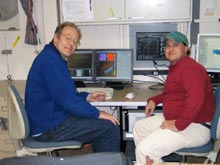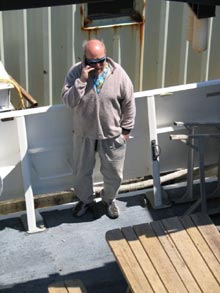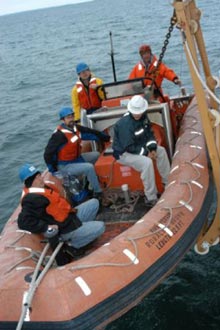The Ronald H. Brown launch is recovered after picking up Jon Howland from shore. (From left) Wayne Smith, the ship's junior engineer; Jon Howland, IFE; Jim Newman, IFE; Bruce Cowden, chief bosun; and Mike Hoshlyk, NOAA executive officer. Click image for larger view.
The Ocean of Wonder
May 9, 2004
Mary Grady
Adjunct Earth Science Instructor
Northeastern University
The longer the island of knowledge, the longer the shoreline of wonder.
— Ralph W. Sockma
After a quiet first night at sea, lingering in the shelter of Martha's Vineyard, the Ronald H. Brown sent a small launch to retrieve our missing software technician from shore. As soon as all climbed aboard, we were off. The ship began to sway gently, and the bow waves ran steady and high, as we set a course for our first dive site: Bear Seamount.
We sailed east-southeast, the waters beneath us growing deeper by the hour. Using the ship’s newly installed SeaBeam software to acquire bathymetric data, we watched the continental shelf gradually descend until we reached the steep continental slope. Perched on the cusp of the continental slope, Bear Seamount is the lowest and oldest of the seamounts on our dive itinerary. The plan for this evening is to acquire bathymetric data during the transit and to fill in data gaps from previous cruises. The SeaBeam technician on board, Joerg Brockhoff, also needs to run the system through a series of tests to correct for artifacts that are appearing. We hope to reach Bear Seamount by early Monday morning.

SeaBeam technician Joerg Brockhoff (left) works with University of Maine graduate student Allan Gontz to acquire bathymetric data in the ship's computer lab. Click image for larger view.

On Mother’s Day, we were in cell phone range. NURC's Peter Auster was among many on board, who took advantage of this opportunity to phone home from sea.
Once the ship started sailing, it didn't take long to lose sight of land. In all directions, we could see nothing but sea, under a low gray sky. "Get used to it," said Diana Payne, Sea Grant education coordinator and a veteran of several research cruises. "That's what you'll be seeing every day for the next two weeks." For folks accustomed to waking up on land every day, it's a sobering thought—a little scary, but exciting, and filled with the promise of adventure.

Members of the science party pose in their survival suits after a drill, with Peter Auster stretched out in front. (Front, from left) Lauren Mullineaux, Catalina Martinez, Diana Payne, Jon Moore, Mike McKee; (back, from left) Susan Mills, Ruth Gibbons, Lance Arnold, Ivar Babb, Kari Heinonen, Mercer Brugler, Scott France, Allan Gontz, and Anne Simpson. Click image for larger view.
We spent all day steaming along towards Bear. It was a busy day: the science team gathered to work out all the details of diving, staffing, and dealing with the mass of data that soon would be streaming in. The Ronald H. Brown crew patiently worked us through the required safety drills. In the science labs, on the decks, and during meals, people met and renewed old ties or introduced themselves to new faces. Outside, the fog drew closer, and the blast of the ship's horn joined the background sounds of slapping waves and nonstop generators. This is the music of life at sea. By day's end, all were eager to get a good night's sleep and to start dives early the next morning.
Sign up for the Ocean Explorer E-mail Update List.






















